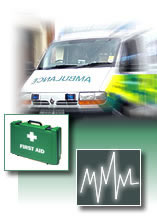| |
BLEEDING
If there is large amount of blood loss
and it is a serious wound, get emergency medical help immediately
by dialling 999 for the ambulance service.
If an individual is bleeding, you need to try and stop the bleeding
and bandage the wound. Whenever possible wash your hands with soap
and water whilst preparing a clean place to administer first aid.
It is important to take precautions, which will then reduce the chance
of infections.
If sterile pads/bandages are not available, everyday material can
be used to control the bleeding in the form of a pressure dressing,
such as towels, nappies, washed clothes and even sanitary towels.
To keep the dressing in place you could use masking tape, strips of
cloth, necktie or pillowcases.
Direct pressure on a dressed wound is an effective way to stop bleeding.
Once the bleeding stops, secure the dressing to the wound. Make sure
you do not cut circulation by over tightening the bandage. Elevation
is also a good method of decreasing and stopping blood loss from an
arm or leg. Raise the limb above the heart whilst bandaging. This
will help relieve pain and slow the bleeding. If a bandage becomes
saturated with blood, cover with more dressing.
The pressure point method would need to be administered, if direct
pressure and elevation does not stop the bleeding. These can be found
at any point where you feel a pulse between the wound and the body.
Pressure Point For Hands: Found on inner side of the wrist.
Pressure Points For Arms: Found located inside each upper arm, between
the elbow and shoulder. You will be basically pressing the brachial
artery against the bone.
Pressure Point For Legs: Found in the groin area, where each leg meets
the torso. Try and press the femoral artery against the bone until
bleeding stop. Always release the pressure point very slowly and if
fresh blood is apparent on the bandage, repeat the procedure.
Serious Internal Bleeding
This usually involves internal organs.
Signs or symptoms can be large bruises, intense pain, pale/cold
skin, dilated pupils, swelling and a weak/irregular pulse rate. Keep the
person warm and comfortable. Do not give any food or drink until
professional medical assistance arrives.
Nosebleeds
Ask the person to sit up with
head tilted forwards. Make them breathe threw the mouth. If the bleeding
is in the front
part
of the nose, pinch the nostrils together for 10 minutes and place
cold wet towels on the nose. Seek emergency medical assistance
if bleeding persists for more than twenty to thirty minutes. Furthermore
do not attempt to stop the bleeding if there is likelihood of
a
fractured skull because this can put pressure on the brain.
Surface Bruises
Signs/symptoms include discoloration caused by
bleeding in tissue near the surface of the skin, swelling and
pain. Put cold
wet cloths over the injured area then apply light manual pressure
to relieve pain and reduce swelling. |
|





